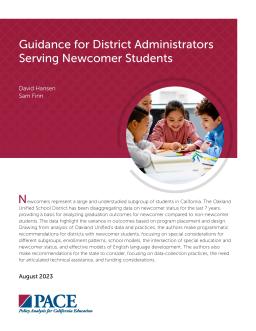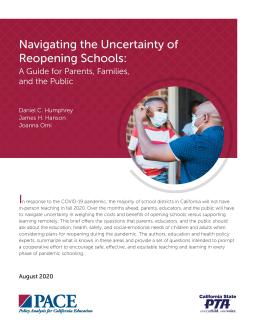A TeachAI Toolkit
Published
Summary
TeachAI—in collaboration with Code.org, CoSN, Digital Promise, the European EdTech Alliance, James Larimore, and PACE—has launched an AI Guidance for Schools Toolkit to help school systems worldwide meet the urgent need for guidance on the safe, effective, and responsible use of artificial intelligence.It helps education authorities, school leaders, teachers, and others create thoughtful guidance to help their communities realize the potential benefits of incorporating artificial intelligence (AI) in education while understanding and mitigating the potential risks.
Published
Summary
Newcomers represent a large and understudied subgroup of students in California. The Oakland Unified School District has been disaggregating data on newcomer status for the last 7 years, providing a basis for analyzing graduation outcomes for newcomer compared to non-newcomer students. The data highlight the variance in outcomes based on program placement and design. Drawing from analysis of Oakland Unified’s data and practices, the authors make programmatic recommendations for districts with newcomer students.
Insights and Strategies From Exemplar School Districts
Published
Summary
This resource guide addresses a key problem that many district and school leaders in California face: how to increase student enrollment and success in A–G courses to reduce equity gaps in college eligibility. Developed from a qualitative research study that examined the policies and practices of nine school districts in California with A–G completion rates surpassing the overall statewide rate, the guide presents strategies, tools, and resources to address challenges with A–G course alignment, counseling, and scheduling.
A Guide for Parents, Families, and the Public
Published
Summary
This brief provides questions for parents, educators, and the public to consider when deciding whether to reopen schools or support remote learning during the COVID-19 pandemic. Education and health policy experts summarize what is known in these areas and provide a set of questions to encourage safe, effective, and equitable teaching and learning during every phase of pandemic schooling.
Research to Guide Distance and Blended Instruction
Published
Summary
This article provides 10 recommendations based on the PACE report to help educators and district leaders provide high-quality instruction through distance and blended learning models in the 2020-21 school year. Despite the challenges of COVID-19, research can guide decisions about student learning and engagement. These recommendations can be used as a framework to prioritize quality instruction.
Published
Summary
California's K-12 public school districts, institutions of higher education, and community organizations are collaborating to improve educational and labor market outcomes. This Resource Guide, based on a qualitative research project, provides intersegmental partnerships with tools to support the development, planning, and monitoring of their data practices. The guide includes critical components of effective strategies for data sharing and use, and can be used as a framework, reflection tool, and networking resource.
A Strategy Guidebook for Leaders
Published
Summary
The Common Core presents challenges for school districts in teaching and learning. This guidebook provides evidence-based solutions to build teacher capacity, address curriculum gaps, design assessments, leverage technology, engage stakeholders, and manage change. It emphasizes the importance of design thinking, focusing on essential change management practices, and connecting the initiative to a broader vision for improved teaching and learning. The goal is to promote innovation, build reciprocal accountability, and effectively address both technical and human dimensions of change.
Published
Summary
The Common Core State Standards (CCSS) aim to improve public education by increasing expectations, deepening subjects, and providing an active curriculum. These goals include addressing disparities in U.S. student performance, reducing remediation rates, improving workplace readiness, and promoting civic participation. Equitable CCSS implementation can help close opportunity and achievement gaps affecting low-income, minority, and English learner students, with all standards expected of all students. California has a unique chance to improve education by implementing the CCSS effectively.
A Guide for Citizens and Candidates
Published
Summary
PACE has published a policy book to support informed debates about the issues facing California education. The book includes recommendations to improve education quality, targeting resources to those who need it most, giving local schools more flexibility, and designing policies for continuous improvement. While there's no one solution to fix public education, a series of good policies can bring about fundamental reform and improve outcomes for schools and students.








